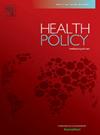Governance of nonpowdered firearms across high-income countries: Results of a scoping review
IF 3.4
3区 医学
Q1 HEALTH CARE SCIENCES & SERVICES
引用次数: 0
Abstract
Background
Nonpowdered firearms are commonly used in recreation but their projectiles can cause serious injuries. Understanding how nonpowdered firearms are governed is essential for injury prevention.
Objective
We aimed to describe legislative, regulatory, and prevention strategies that govern nonpowdered firearms in Organization for Economic Co-Operation and Development (OECD) countries.
Methods
We searched multiple academic databases and grey literature for information on nonpowdered firearm governance. Data were extracted and grouped into themes: weapon definitions, licensure, age restrictions, permitted locations for use, storage and transport, sale and transfer, imitation firearms, import/export, manufacturing, advertising, and monitoring systems. We conducted a comparative analysis of legislative frameworks, regulatory standards, and enforcement strategies.
Results
Our findings revealed that 31 OECD countries (84%) have documented governance of nonpowdered firearms. Definitions for what constitutes a nonpowdered firearm varied based on the projectile mechanism (air, spring) and specific muzzle energy/velocity. In 61% of countries, licensure and age restrictions were mandatory. Regulations on use locations, storage, sale, and transfer were found in 26–32% of countries. Monitoring systems for production, sale, or possession existed in 13 countries. Injury surveillance systems were not readily identified.
Conclusions
While commonalities exist nonpowdered firearm governance, substantial heterogeneity and gaps remain in legislation. This becomes problematic when governance approaches lack a foundation in clinical or physical evidence, limiting effective injury prevention. Evidence-informed definitions and methods to assess injury potential are essential for improving surveillance and guiding regulation. Strategies such as age and marketing restrictions, licensure, and safety equipment (eye protection) should be grounded in science. International guidance can support coherent, adaptable approaches across jurisdictions.
高收入国家非粉末枪支的治理:范围审查的结果
非粉末枪支通常用于娱乐,但其弹丸可造成严重伤害。了解如何管理非粉末枪支对伤害预防至关重要。目的:我们旨在描述经济合作与发展组织(OECD)国家管理非粉末枪支的立法、监管和预防策略。方法检索多个学术数据库和灰色文献,获取非粉末枪支治理的相关信息。数据被提取并按主题分组:武器定义、许可证、年龄限制、允许使用地点、储存和运输、销售和转让、仿制枪支、进口/出口、制造、广告和监控系统。我们对立法框架、监管标准和执法策略进行了比较分析。结果:我们的研究结果显示,31个经合组织国家(84%)已经记录了对非粉末枪支的管理。根据弹丸机制(空气、弹簧)和枪口能量/速度的不同,对非粉末状火器的定义也有所不同。在61%的国家,执照和年龄限制是强制性的。26-32%的国家对使用地点、储存、销售和转让有规定。在13个国家存在生产、销售或持有的监测系统。伤害监测系统不容易确定。结论:尽管非粉末状枪支治理存在共性,但在立法上仍存在实质性的异质性和差距。当治理方法缺乏临床或物理证据的基础时,这就会成为问题,限制了有效的伤害预防。基于证据的定义和评估潜在伤害的方法对于改进监测和指导监管至关重要。诸如年龄和销售限制、许可证和安全设备(护眼设备)等策略应以科学为基础。国际指导可以支持跨司法管辖区采取协调一致、适应性强的方法。
本文章由计算机程序翻译,如有差异,请以英文原文为准。
求助全文
约1分钟内获得全文
求助全文
来源期刊

Health Policy
医学-卫生保健
CiteScore
6.40
自引率
6.10%
发文量
157
审稿时长
3-8 weeks
期刊介绍:
Health Policy is intended to be a vehicle for the exploration and discussion of health policy and health system issues and is aimed in particular at enhancing communication between health policy and system researchers, legislators, decision-makers and professionals concerned with developing, implementing, and analysing health policy, health systems and health care reforms, primarily in high-income countries outside the U.S.A.
 求助内容:
求助内容: 应助结果提醒方式:
应助结果提醒方式:


